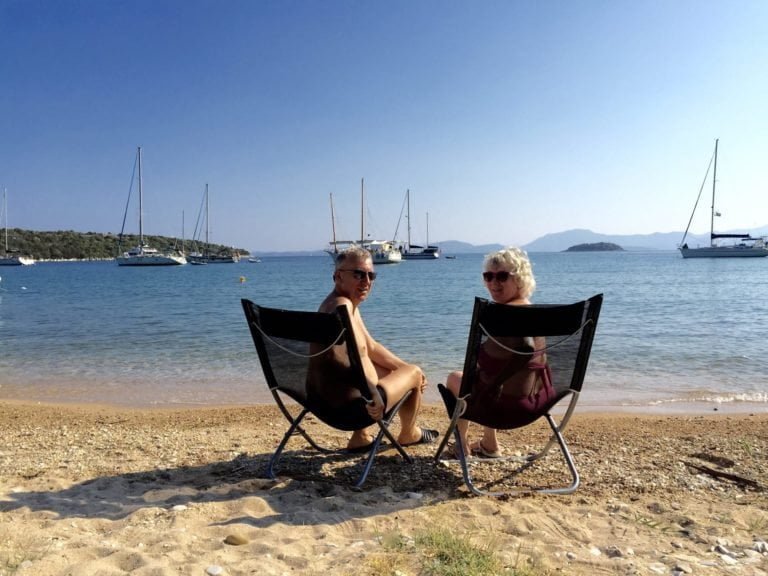Imagine waking up to the gentle rocking of the ocean, surrounded by the serene blue expanse, with the horizon stretching endlessly around you. Well, that was what I thought it would be like to live on a sailboat. I knew nothing about sailing, boats, navigation on the high seas or, in fact, anything to do with boating. I just wanted to get out of the daily grind of work, work, work.
Since the day in June 1994 when a work colleague gave me a book to read called “Voyaging on a Small Income by Annie Hills, I had made it my mission to create that perfect liveaboard lifestyle. That living on a sailboat lifestyle became a reality on the 31st of July 2001. Last year, in June 2023, Ann and I sold our home for over twenty-three years and became landlubbers again.
I know that there are a growing number of adventurous souls out there who are also researching this dream; they are trying to make it their everyday reality, too. Living on a sailboat offers a unique lifestyle that’s equal parts exhilarating, challenging, and deeply rewarding. This post delves into its practicalities, benefits, and challenges on the water and offers a glimpse of the thought processes, decision making, problems and solutions that Ann and I had which are all part of the captivating world of liveaboard sailing.
Table of Contents
The Allure of the Sea
The appeal of living on a sailboat lies in its promise of freedom and adventure. It’s about escaping the confines of conventional living and embracing a minimalist, mobile lifestyle.
Here are a few reasons why Ann and I chose to live on a sailboat:
Freedom and Flexibility
One of the biggest draws is the freedom to travel. We wouldn’t be bound by the limitations of roads and motorways, small narrow lanes or dead ends; we could chart our own course to virtually anywhere in the world. The lure of exploring remote islands, vibrant coastal cities, and untouched natural beauty was a powerful motivator.
Connect with Nature
Living on the water would provide an intimate connection with nature. Every day is spent immersed in the natural world, from witnessing breathtaking sunrises and sunsets to encountering marine wildlife up close. The rhythm of this life would be dictated by the wind, tides, and weather, fostering a different kind of respect for the elements.
Simplified Living
The limited space on a sailboat necessitates a minimalist lifestyle. This simplification was, in a way, liberating, encouraging us both to focus on what truly matters and to value experiences over possessions. In real terms, it was an end to a means. Mainly to escape the awful rat race we were part of.
The Practicalities of Living on a Sailboat
Choosing the Right Boat
Selecting the right sailboat is crucial for a successful liveaboard experience. Factors to consider include size, layout, build quality, and sailing performance.
The yacht we decided on would be 12 meters or less as we discovered that marina pricing significantly increased beyond this length, making it a key factor in our decision.
Additionally, yachts exceeding 12 meters required more costly equipment, including navigation lights, larger winches, cleats, windlasses, anchors, chains, and mooring warps.
With our experience sailing a Sigma 38 (all gained on various sailing courses up to yacht master), we felt confident in managing a yacht of this size. The Bruce Roberts Spray 38 offered ample space for all our belongings and appeared to be a popular choice for those looking to build their own yacht.
Comfort and storage space are essential for liveaboard purposes, and the Spray designs could carry a huge payload. All this balances liveability with manageability. Bruce Roberts said he could design a yacht that has two of the following characteristics: speed, seaworthiness, and comfort. Ann and I chose seaworthiness and comfort.
Costs and Budgeting
While living on a sailboat can be economical compared to traditional housing, it comes with its own set of costs. Let’s leave aside the initial expenses, such as the purchase of the boat and necessary outfitting for liveaboard life. Ongoing costs encompass maintenance, marina fees, insurance, and fuel. Hauling out every 12 to 24 months is a significant cost. For us, it ranged from €600 in Greece to £900 in the UK.
Our aim was to only lift out every two years rather than the industry norm of one year. Marina-wise, we only planned to stay in a marina during the winter. Our cruising ground would be the Mediterranean, and we initially thought we could stay out of marinas until the start of December.
However, this soon was proven to be a silly conclusion. The Med can be rough, with winds and storms howling through at an unbelievable rate. Most years we headed for the safety of a marina around November time.
Living Space and Amenities
Space is obviously limited on a sailboat, so efficient use of every inch is essential. Most Tupperware boats bought as liveaboard yachts are ill-equipped for serious liveaboard cruising as they are designed for the weekend or charter market.
Ann and I chose to build our own yacht. The hull was designed by Bruce Roberts, who took that well-proven seaworthy wooden Spray hull design and converted it to be built in either fibreglass (Tupperware), aluminium or steel. The Bruce Roberst build plane for Spray have the following layout:
- Sleeping quarters: The design has an aft cabin and a forward cabin. The aft and forward cabin both have double berths. There are also two main cabin (salon) berths, which are two single berths converted from the settees.
- Galley: A compact kitchen with a gimbaled cooker, with oven, sink, and storage for provisions.
- Head: The bathroom typically has a marine toilet and a shower. In Bruce Roberts’s plans, this is situated in the starboard walkthrough.
- Salon: The communal living area that doubles as a dining space. A place to relax on cold winter nights and hide too keep cool on hot summer days.

Of course, as we built our own yacht, we had free reign on how the interior layout was arranged. Mr Roberts said, “Do what you like, she can handle the weight”. So, Ann and I decided that on our version of Spray; we would not have the forward cabin.
Instead, the heads would be in that space. The Lavac sea toilet is to port, and a full-size wash basin to starboard with the shower tray in the middle. When not in use, the shower tray was covered with Sapele boards. These were removed, and you can step down into the tray and pull the shower curtain around for an ‘in-a-house’ showering experience.
Energy and Water Management
Sustainable energy and water management are critical on a sailboat. As liveaboards, we relied on a combination of solar panels and alternator power to generate electricity.
For the first five years, we sourced freshwater from marinas; thereafter, we invested in a Schenker Smart 30 Watermaker (desalinator), which allowed us to be fully self-sufficient. Again, initially, we only had 330 Amp Hours of 12-volt battery capacity. Which was a little naïve of me.
Three years later, this was upgraded to 6 x 225 Trojan 6 Volt cells, which together made up 675 Amp Hours capacity. With this, we were truly self-sufficient. I added a Victron Multi Inverter/Charger with which we could run a 3.5kg Candy washing machine and all the other electrical items that make up a true blue water long-range liveaboard yacht.
Communication and Connectivity
Staying connected is important for safety and practicality. VHF radios are essential for communication with other vessels and marinas; we did not have a satellite phone as we never crossed the Atlantic.
For the first six years, we used on route internet cafes to stay in touch. Used Navtext and VHF radio and said internet cafes for weather forecasts. But when mobile broadband was made more cost-effective around 2007 we invested in a data sim card in each country we visited.
Initially, this was not easy; there were lots of restrictions, and in some cases, you had to have a local address, but each time, with a bit of persuasion, we managed to secure a sim card.
These days it is much easier and internet devices provide global connectivity for navigation, weather updates, and keeping in touch with loved ones.
The Challenges of Living on a Sailboat
Space Constraints
Living in a small space requires significant adjustments. Ann and I lived on our yacht, Ruffles Spray, for over twenty-two years—24 hours a day, 7 days per week, 365 days a year. Think about how you will get on with your partner, wife, husband, boyfriend, or girlfriend.
It does take a different mindset. Don’t forget privacy is limited, and the lack of storage demands careful organisation and prioritisation of belongings, especially if you opt for a production yacht.
These are not built for local carrying; they are designed for the charter market. In these types of yachts, every item must have a purpose and a designated place; otherwise, you’ll spoil their trim.

Weather Dependency
Sailboat living is heavily influenced by the weather. Storms, high winds, and rough seas can disrupt plans and pose safety risks.
The skipper is constantly monitoring weather conditions and in anchorages, monitoring who is anchored where, how far they are anchored from your boat, and whether they are dragging.
Be prepared to get underway at a moment’s notice. One of our remembered experiences was anchored in a bay on the Italian island of Ponza, the yachts for anchored so close you could nearly walk across them to get ashore with dry feet.
Maintenance
Boats require regular maintenance to stay seaworthy. This is where Tupperware boats shine. Steel yachts like Ruffles Spray do require painting.
A lot of painting. But I would rather be in a steel yacht than a Tupperware one. All those floating lost containers, those sunken tree trunks, I wouldn’t like to run into one in a Tupperware boat.
Other maintenance such as cleaning, engine upkeep, sail repairs, and checking the hull and rigging are technically the same. Don’t forget the marine environment is harsh, and salt water can cause corrosion and wear over time to either boat material.
Isolation
Many friends and family have commented that they couldn’t be isolated from the world on a yacht. Ann and I found that the solitude of the sea is appealing.
The only time it can also be isolating is when you get caught out by heavy weather. Our baptism for this came early when we crossed the Bay of Biscay in July 2002.
The forecast was for five days of calm, but on day three we awoke to a large swell coming from the South West. Of course South West was our direction of travel.
To cut a long story short this storm was not nice and luckily we have not had to endure another one like it. If you are interested, you can read my book Getting Away. A memoir about how Ruffles Spray was built and our subsequent voyage from the UK to The Med.
The Rewards of Sailboat Living
Unmatched Experiences
Living on a sailboat offers experiences that are hard to come by in conventional life. Imagine snorkeling in crystal-clear waters off a secluded Greek island, watching dolphins play in your bow wave, or dining under a canopy of stars in the middle of the sea watching the night sky, taking in the magical sight of the milky way as it stretches out from horizon to horizon.
Personal Growth
The challenges of sailboat living foster resilience, self-reliance, and problem-solving skills. Before we set off, both of us had learned new skills such as navigation, marine mechanics, and weather forecasting.
The lifestyle demands adaptability and resourcefulness. If you can’t fix all the equipment on the vessel, you’ll be forking out huge amounts of cash to those who can. In most marinas, there is a camaraderie between sailing folk, and we all help out.
But remember, when things break, it won’t be in a marina. It will be out in the wilderness of the sea far away from land, on a stormy night with no moon or stars to illuminate the issue. My advice learn as much as you can and do all the repairs yourself.

Sense of Community
Despite the isolation, the sailing community has a strong sense of community. Marinas and anchorages are social hubs where liveaboards share stories, advice, and camaraderie. This network of fellow adventurers provides support and friendship.
Environmental Stewardship
Living closely with nature often creates a heightened sense of environmental responsibility. Many liveaboards adopt sustainable practices such as reducing plastic use, minimising waste, and protecting marine ecosystems. Never throw anything overboard you either haven’t eaten or cooked.
A Day in the Life of a Liveaboard
What does a typical day look like for someone living on a sailboat? While every day can be different, here’s a glimpse into the rhythm of sailboat life:
- Morning Routine: The day often begins at sunrise. After breakfast in the salon, it’s time to check the weather forecast and make any decision to sail to the next anchorage or stay anchored and carry on watching the day go by. Have a swim or maybe a paddleboard session.
- Sailing or Maintenance: If it’s a sailing day, they then hoist the sails, plot a course, and navigate to the next destination. If staying put, the day might involve boat maintenance, cleaning, or exploring the local area. There’s always time for a cold beer in a taverna.
- Afternoon Exploration: Late afternoons on Ruffles Spray were always for leisure and exploration. This could mean snorkelling, fishing, visiting a nearby town, or hiking onshore. We always left provisioning and restocking supplies for when we were tied to a town quay or in a marina as local knowledge on the whereabouts of the best supermarkets was readily available for the locals.
- Evening Relaxation: Evenings are typically spent on board, enjoying a meal prepared in the galley. Socialising with other liveaboards, reading, or stargazing are common activities. The gentle rocking of the boat and the sounds of the sea provide a soothing backdrop for winding down. A gin and tonic in the cockpit whilst watching the sun go down is worth all the other things a liveaboard has to put up with.
Tips for Aspiring Liveaboards
- Start Small: Before committing to full-time sailboat living, try it out for shorter periods. Chartering a boat for a few weeks, a few flotilla holidays or taking extended sailing trips as a crew member can provide a taste of the lifestyle and help identify preferences and needs.
- Educate Yourself: Knowledge is power when it comes to sailing. Take courses in sailing, navigation, and marine safety. Take all the RYA courses, both theory and practical, to learn the ropes from scratch. Books, online resources, and sailing schools offer valuable information. Joining a sailing club or community can provide mentorship and practical experience.
- Plan and Prepare: Thorough planning is crucial. Consider the logistics of living on a sailboat, including budgeting, outfitting the boat, and mapping out potential routes and destinations. Being prepared for emergencies and unexpected situations is essential.
- Embrace Minimalism: Living on a sailboat requires a minimalist mindset. Prioritise essential items and be prepared to let go of unnecessary possessions. Focus on quality and multifunctional items to make the most of limited space.
- Stay Flexible: Flexibility is key to sailboat living. Weather, mechanical issues, and other factors can disrupt plans. Adaptability and a positive attitude will help navigate the challenges and enjoy the journey. Both these are the key ingredients of a liveaboard mindset.
Is a Life of Adventure for You?
Living on a sailboat is not for everyone, but for those drawn to the sea, it offers unparalleled adventure and freedom. The challenges are real, but so are the rewards. It’s a lifestyle that fosters a deep connection with nature, personal growth, and a sense of community with fellow sailors. Ann and I thoroughly enjoyed our liveaboard years, we wouldn’t have missed it for the world.

For those who dream of waking up to the sound of waves and the promise of a new horizon daily, sailboat living can be a dream come true. It’s about embracing simplicity, adventure, and the timeless allure of the open sea.
So, if you’ve ever felt the call of the sea, perhaps it’s time to set sail and discover the world from a new perspective. If you have a burning question, ask them in the comments, and I will endeavour to reply.
For those who dream of waking up to the sound of waves and the promise of a new horizon every day, sailboat living can be a dream come true. It’s about embracing simplicity, adventure, and the timeless allure of the open sea.
So, if you’ve ever felt the call of the sea, perhaps it’s time to set sail and discover the world from a new perspective. Have a burning question ask them in the comments, and I will endeavour to reply.





